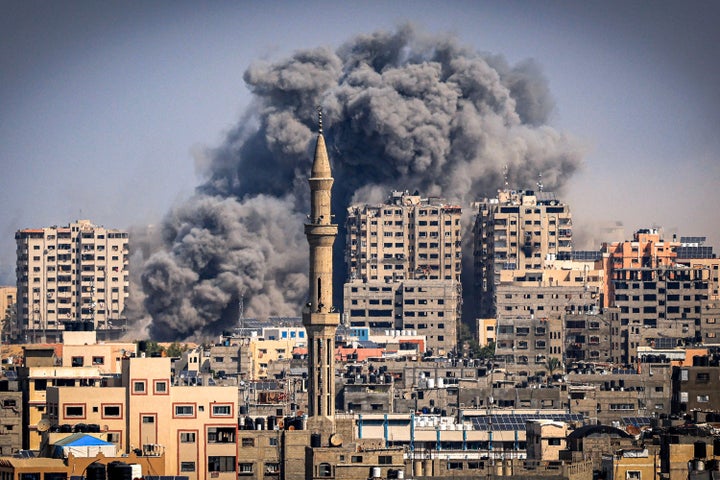
People around the world have been horrified by the sudden outbreak of war in Israel over the last few days – but this row with the Palestinians goes back a long way.
The Palestinian militant group, Hamas, launched an unexpected and extremely deadly attack on Israel on Saturday. Israel then quickly retaliated, declaring war on the group and announcing a complete siege on Gaza.
To help you understand exactly why this conflict is so complicated, here’s a look back at the history between these two factions.
What is Israel’s historical significance?
Israel, which is around the size of New Jersey in the US, is on the shores of the Mediterranean Sea and bordered by Egypt, Jordan, Lebanon and Syria.
It currently has a population of more than nine million and is predominantly made up of Jewish people, but it contains sites sacred to Muslims, Christians and Jews.
Both Jews and Muslims can trace their origins in the land back to the historical figure of Abraham, who lived in the region around the 18th Century BCE (according to religious texts).
He is also regarded as the father of both Judaism – through his son Isaac – and the father of Islam – through his son Ishmael.
However, the area was repeatedly conquered and ruled by different groups for years, and eventually seized by the Ottoman Empire in the 16th Century.
It changed hands again in the 20th Century though.
What happened in the 20th Century?
In 1917, Britain promised to establish a “national home for the Jewish people” in Palestine through something called the Balfour Declaration.
The vow was made in a letter from the-then foreign secretary Arthur Balfour, and sent to Lionel Walter Rothschild, a key figure in the British Jewish community.
The promise came about as the Ottoman Empire was dissolving, and Britain had moved in to conquer Palestine.
The letter also included the condition that “nothing shall be done which may prejudice the civil and religious rights of existing non-Jewish communities in Palestine” – but notably said nothing about their political rights, as GCHQ points out.
How was the Balfour Declaration received?
The Palestinian population condemned the policy, claiming Britain was giving away land which wasn’t theirs in the first place.
Worried they could be displaced, the population tried to resist the British policy through boycott and civil disobedience, but to little success.
But, the Israelis still see it as an essential part of their state’s history.
For instance, the official resident of the prime minister in Jerusalem is on Balfour Street, and a Tel Aviv school also carries the Balfour name.
What was the British Mandate of Palestine?
In 1922, the League of Nations – the first worldwide intergovernmental organisation for world peace, formed after World War 1 – awarded Britain the Palestine Mandate, thus endorsing the Balfour Declaration.
The mandate meant World War 1′s victors would govern territories which used to belong to the countries which lost, until they could become independent.
After years of civil disobedience, in 1936, Palestine started to use arms, and tried to stop mass Jewish immigration.
Two divisions of the British Army were then deployed to restore order.
Then, after the Holocaust of World War 2, which saw six million European Jews killed, the community who supported the Zionist movement – the establishment of a Jewish state in Palestine – pushed harder for their own state.
And, in July 1946, an underground Jewish Irgun group which wanted independence from Britain, bombed the King David Hotel, killing Arab and Jewish staff, as well as British citizens.
What happened when Palestine officially split?
GCHQ’s website explains Britain admitted it could no longer manage the problems in the region and referred the problem to the UN in 1947.
Britain announced its plan to withdraw from Palestine, and the UN General Assembly voted in favour of splitting Palestine into an Arab state and a Jewish State.
This was rejected by Arab figures.
Still, Israel’s founding father David Ben-Gurion declared independence on May 14, 1948, the day before the British rule ended.
Approximately 700,000 of Arabs – half of the Arab population of British-ruled Palestine – fled.
Millions of their descendants are still stateless refugees, and many moved into Jordan, Lebanon, Syria, Gaza, West Bank and East Jerusalem.
Palestinians call the creation of Israel the Nakba – or the catastrophe.
However, Israel claims it did not drive Palestinians from their homes, and instead notes that it was attacked by five Arab states the day after its creation.
Armistice pacts meant this fighting ceased in 1949 but there was no formal peace.
In the years that have followed, violence has plagued the region.
For instance, Israel made a pre-emptive strike against Egypt and Syria for the 1967 Six-Day War.
Through this war, Israel secured the the West Bank, Arab East Jerusalem (which it captured from Jordan) and Syria’s Golan Heights.
Then Egypt and Syria attacked Israel along the Suez Canal and Golan Heights for the Yom Kippur War in 1973, but Israel pushed them back within three weeks.
Israel also invaded Lebanon in a 10-week siege in 1982, and another war erupted in 2006 in Lebanon over captured Israeli soldiers.
Conflicts have also raged in Gaza since Israel left the land in 2005.
